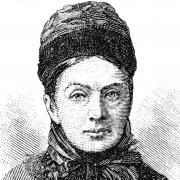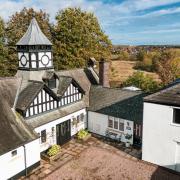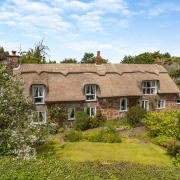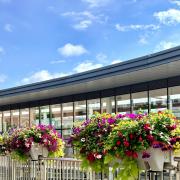Second-generation glassblower Charlie Burke and his wife Amelia are building their own reputations in the world of glass art, from their home and studio in Malpas
Ed and Amelia Burke create beautiful works of glass art and collectable glassware, whether that be a gin tumbler, a perfume bottle, a wall plaque, or a bowl you’d never place anything in. In this respect, they are walking respectfully in the footsteps of Charlie’s mother and father, Margaret and Ed Burke, who established E&M Glass in the late 1980s and sold their work all over the world.


Most glass studios, particularly in London, where his parents were working at the time, sit on industrial estates, which offer very little in terms of comfort and inspiration, not to mention the views, so Charlie’s parents decided to make a bold move out to the country, settling in a tiny hamlet close to Malpas.
“I came along in 1987, and my parents wanted to give me a small village upbringing, with green all around,” Charlie explains.

“It’s all about contacts,” Charlie says. “They did the British Craft Trade Fairs and mum met Terence Conran and did a lot of work for The Conran Shop. He really helped them understand the US market too, understanding the different styles of the East and West coasts and so when they did British Craft Council Fairs in the USA in the 1990s and early 2000s they soon gained a following. Mum’s Doodle design became quite famous, and her work was picked up by SAKS and Barney’s, she even got a private commission from Christian Dior New York. We still get emails from people who bought her work, sets of cocktail glasses for example, who want to order replacements. The Four Seasons in Hawaii used mum’s cocktail glasses in their bar, and still have them. We can of course replace them still, as mum’s still making. After 911, the market changed and the desire to be travelling to the USA changed, so they directed their efforts into doing UK shows and fairs.”
While, sadly, Ed passed away in 2023, Margaret is still a major force in the business, creating her own stunning work and travelling the country giving live glassblowing demonstrations, exhibiting and selling her work. She specialises in surface work, which uses multiple techniques to create beautiful pieces.
“I will blow vessels to my mum’s design – in terms of colour and shape, layering different shades within one glass vessel and finishing with a coat of black. She then draws her design onto the glass and uses a tiny sandblaster, or etching tools, to create her design. The more glass she takes off, the more of the colours beneath are revealed.”

Charlie is one of only three second generation glassblowers in the UK, having been fascinated by the process – and its results – since he was small.
“Growing up I always wanted to be involved,” he says, “and they wanted to teach me to do it properly as it’s very high risk. I learned all the techniques – well, when they had an order for a thousand glasses to get out, it was all hands on deck – but it wasn’t till I went to university I got the chance to ‘play’ with glass and get creative in my own way.”
Charlie studied at Sunderland University, starting a Fine Art degree, but swiftly transferring to a Glass & Ceramics course, to nobody’s surprise. From here, like his parents, he went on to learn with a number glass studios around the UK, before taking a role at The World of Glass in St. Helens, which is where he met his now wife, Amelia.

“I studied 3D Design at Manchester,” Amelia says, “and as part of my final year project I did a commission for Manchester Children’s Hospital. One day the furnace in the university stopped working, so my tutor arranged for me to use the furnace at World of Glass, in St Helens. When I met Charlie I already knew about his family, as his dad wrote a book about glass blowing techniques that was required reading on my course. Ironically I am the only person in this family to have actually read it.”
The rest, as they say, is history.
In 2013, with both Charlie and now also Amelia working in St Helens, they took the decision to move to Malpas, for much the same reasons as Ed and Margaret first moved there.
“Amelia had a daughter, Ruby, and we wanted her to have a village upbringing,” Charlie says.
By 2016 Charlie and Amelia realised they were spending so much time in the family business or St Helens they were actually at risk of losing all the reasons they chose to live in Malpas in the first place, spending every weekend at fairs around the UK, doing glassblowing demonstrations, or running classes at the museum, so they handed their notice in and stepped full-time into E&M Glass.
“At the same time, Ruby was diagnosed with Type 1 diabetes, so we decided we always had to have one of us at home,” Charlie says. “In 2019 I did 35 shows, with my mum and dad, all over the UK. Amelia was pregnant, so stayed home with Ruby. It was a massive commitment – you work for five days blowing the glass you plan to sell at the show, and then go to the show for two days. We knew we needed to scale it back, and then Covid hit.’

For the first time in years, the family turned off their gas-powered glass furnace and took a moment.
“It gave us time to reflect and reassess. We moved to a more economical electric furnace, and it was like a lightbulb going on – the less time we had the furnace on, the less glass we needed to make to fund having the furnace on. We were able to do fewer shows and get our work into more galleries.
“We were also able to ask ourselves: ‘what is the work we want to make?’ We could develop our own style and really start getting creative again. We also developed a glass-blowing course programme and sold a lot of vouchers for when people were able to get out and do things again.”

The opportunity to get creative has led to an exciting development for Amelia, who has just won a grant from the Art Council of Wales to develop her work in a very specific direction.
“During my degree I was very interested in how we could bring art and healthcare together, which I was able to explore with my final project and the commission for Manchester Children’s Hospital. During the pandemic, I started developing my skills in ‘murrini’ glassblowing, creating vessels and wall art that uses canes of different coloured glass to create unique patterns.”
Murrini, or murrine, glass production was first developed more than 4,000 years ago in the Middle East, then was revived by Venetian glassmakers on Murano in the early 16th century. You may have seen the famous extrapolation of the art in the ‘Millefiori’ paperweights, for example, where dozens of coloured glass canes, with a central coloured heart in the shape of a flower, all packed together to create a bouquet of glass flowers. Amelia discovered that by making glass canes and blowing her vessels in a certain way, she could recreate cell structures, giving her work a botanical feel.
“I can create my own canes in the colours of my choice, which I can then stretch out (when hot) to various circumferences and then set in a panel, which I can ‘slump’ over a mould to create wall art, or dishes, for example, or blow into vessels.

“I started to get interested in how I might use this technique to create cell structures related to Type 1 diabetes. I was talking about this to the director of Ruthin Arts Centre, and he helped me put a bid together for a grant from the Arts Council of Wales. I want to use my art to raise awareness of Type 1 diabetes. I am so excited to have received a grant to do this, and be given the support of two glass artist mentors – Verity Pulford and Neil Wilkin. The plan is to develop my technique and my vision to create a body of work which can then be exhibited in galleries around the UK, raising awareness of Type 1 diabetes and drawing a new audience to glass art.”
It seems E&M Glass’s new generation of glassblowers are taking the family business to new heights of creativity, finding their own creative heart while sharing the joy with anybody who wants to learn how it’s done in their regular classes. Win win.




























